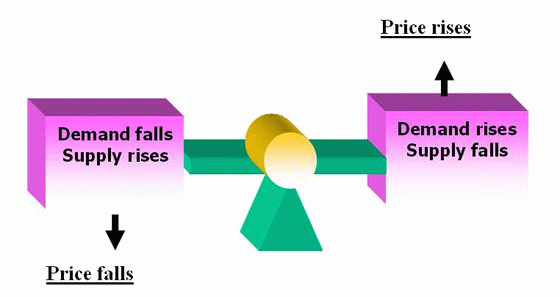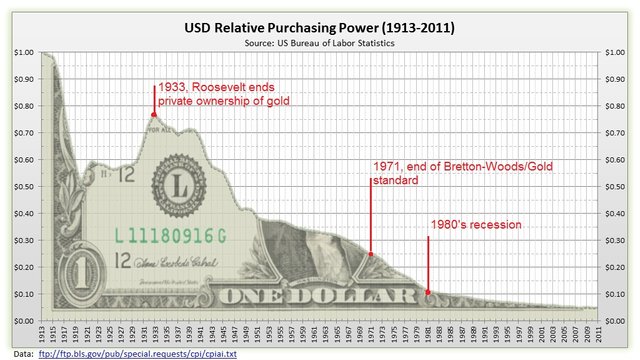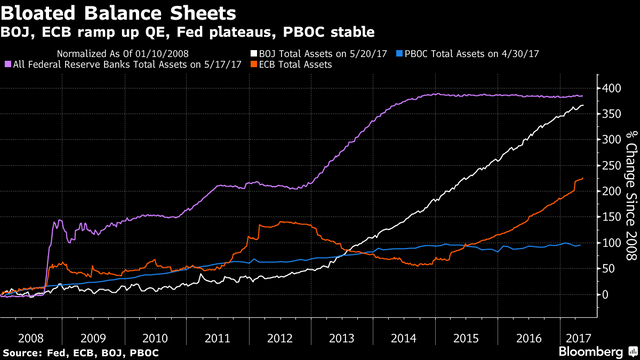Quantitative easing (QE) is a topic that is well-covered these days, especially within the cryptocurrency and precious metal communities, for better or worse. QE is often cited as one of the most compelling bullish developments relative to alternative investments because QE has diluted the value of every fiat currency through an increased supply, thereby reducing value, since demand is relatively stable (if not decreasing).

There is not necessarily more fiat in circulation, but there is more fiat-denominated debt floating around on central bank balance sheets, which has the same devaluing effect on the underlying fiat asset.
Regardless, the argument is that a weakening fiat currency system is bullish for these alternative assets because as folks realize their paper money is being inflated away in value and earning practically zero interest, they will flock to assets that offer an alternative to fiat. These alternatives are namely precious metals and cryptocurrencies. Of course there are others (such as real estate, art, and physical goods), but precious metals and crypto appear the most accessible, so I will focus on these.
Here is a chart depicting the loss of purchasing power in USD:

As I said, this is likely a topic you’ve read so much on that you are already bored.
The thing that most people miss in their discussion of QE, however, is the fact that not only has the value of fiat currency been undermined, but the pricing mechanisms used throughout our global economy have been manipulated to coincide with the policies supporting QE.
In short, central banks have been able to pursue QE by creating an environment of extremely low interest rates. They lowered interest rates to artificial lows by buying obscene amounts of bonds. With central banks dumping all of their QE money into the bond markets, they essentially mispriced all other assets in equities, real estate, you name it. This is because the market, as a whole, relies on the bond markets as the incorruptible safe-haven. Bond markets were thought to be too large for any one entity to manipulate, yet the Fed and central banks have achieved exactly this using QE.

The Fed (and all other central banks) have chosen a path of QE primarily for two reasons:
(1) Governments will always continue to raise their own budgets. After all, they must be compensated for inflation each year, right?
(2) Governments will always fight to remain in power. QE allows governments the option of maintaining artificially low interest rates by pumping newly created money into bond markets. The reason they want low interest rates is because low interest rates make voters feel wealthy. Voters with some change in their pockets will re-elect over their debt ridden counterparts. Low interest rates also allow the government to repay their debts with minimal interest payments; meaning they can pile more debt onto the debt load and continually "raise the ceiling".
*It's worth mentioning that I use the terms "government" and "central bank" interchangeably. For all intents and purposes, central banks are politically-based, despite what people may tell you. Similar to the notion of separation of church and state; it sounds nice, but in reality almost all US Presidents are Christian.
Let’s break this down a bit. Name one government in history that freely chose to decrease its own budget. In other words, identify a single politician who willingly voted to decrease the amount of money he/she brought home to the family at the end of the day. Governments are like a self-fulfilling prophecy. Anytime a group of people are brought together, they are going to do what serves the group the best. It’s only human nature, so you cannot really blame them for looking out for themselves and their families.
However, when this same group of people is given power over all others, it then becomes a dangerous proposition. That is what I mean by self-fulfilling prophecy. Whatever this all-powerful group decides is best for themselves will be signed into law and carried through the socioeconomic and legal process to our door front. It is usually in the form of taxation, one way or another. Like everything else, it’s all about the money.
In a desperate attempt to see that their budgets are not slashed, governments took to the bond markets to make sure that the money kept flowing into the economy, and thereby, their own pockets. By printing unlimited money and pumping it into bonds, the government was able to keep the price of money (interest) down to historic lows.
As a result, corporations and common people could go out and borrow money to purchase assets. Because it was so cheap to borrow money and buy assets, the prices of assets went up as more people had the ability to bid on an asset with loaned money. So real estate and equities went up in price so long as the Fed was buying obscene amounts of bonds. As long as the bond markets were in a bull market, so too were equity markets and real estate markets. This was because the pricing mechanisms were corrupted from the top down, beginning with the once-thought immutable bond markets and spreading through the smaller equity and real estate markets.
These rising asset prices made people feel like they were rich. They watched as their investments in stocks, bonds, real estate, etc. went up in value. This time, things were truly different. Perhaps this bull market will last indefinitely.
In return, the people voted to maintain this establishment of government by focusing only on the Presidential election when the established government sits in Congress and the House of Representatives.
Back to QE…
The Fed stole the savings of people who kept their funds in the banks. Savers did not receive interest payments because the bond markets were flooded with printed QE money to keep interest low, remember? So, in realizing this, everyone poured their savings into bonds, equities, real estate, college educations, new cars, consumer spending, etc. in search for yield on their capital. The system was rigged to get everyone’s wealth into the markets, be it credit or debt. I have written about this trend previously via the proliferation of passive investing and the extreme amounts of debt that we all find ourselves in.
The problem was that the only reason this was happening was because the Fed managed to drive interest rates down so low by manipulating the bond markets. The Fed could simulate a healthy, growing economy by simply dumping QE funds into bonds.
It should be clear that this is not a sustainable system. Many folks seem to be catching onto this, be it the precious metal advocates, cryptocurrency advocates, the Republicans, the Democrats, the libertarians, etc. The Fed knows this, and therefore they have reversed course and made its intention to raise interest rates painfully clear.
They have to make this reversal so clear so that all of the major corporations and banks have time to reorganize their investment portfolios accordingly. That is why anytime a Fed meeting is announced, it comes out several months in advance. That is also why the meeting minutes and interviews of Fed chair Janet Yellen are followed so closely; because Yellen is telling everyone where the largest flows of liquidity (QE money) are headed next.
Stay tuned for Part 2.
DISCLAIMER : This content is for informational, educational and research purposes only. This post is not to be taken as personalized investment advice.